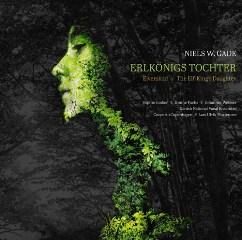Niels W. Gade - Elverskud (The Elf-King's Daughter) [2018]
Niels W. Gade - Elverskud (The Elf-King's Daughter) [2018]

1 Prolog: "Herr Oluf Abends hielt an sein Ross" 3:12 2 No. 1 "In’s blaue Meer die Sonne sinkt" 4:40 3 No. 2 "So oft mein Auge die Fluren schaut" 4:40 4 No. 3 "Zäum’ auf mein Ross" 3:44 5 No. 4 "Nacht, o wie stille" 4:12 6 No. 5 "Leicht nun schwebt der Tanz" 2:28 7 No. 6 "Willkommen, Herr Oluf" 5:52 11,81 kr. 8 No. 7 Morgengesang: "Im Osten geht die Sonne auf" 2:48 9 No. 8 "Ich wartet’ an des Hauses Thür" 5:03 10 No. 9 "Hör’ du, Herr Oluf, sag’ an mir" 5:19 11 Epilog: "Drum rath’ ich jedem Jüngling an" 1:11 Sophie Junker - soprano Ivonne Fuchs - alto Johannes Weisser - baritone Danish National Vocal Ensemble Concerto Copenhagen Lars Ulrik Mortensen - conductor
Elverskud (The Elf-King’s Daughter) is a dramatic cantata from 1854, based on Danish medieval ballads. It became one of Niels W. Gade’s greatest successes, not only in his native Denmark, but throughout Europe, where Elverskud was performed several hundred times, often conducted by Gade himself. Gade was especially admired in Germany, and on this album Elverskud is not only played on period instruments for the first time, but is also sung for the first time with the German text that brought the work international fame. Perhaps this Danish national work isn’t so Danish after all? ---dacapo-records.dk
The first half of the nineteenth century was the age of National Romanticism in Denmark. In literature, art and music this period was characterized by an intense preoccupation with Norse mythology, the old Danish popular ballads and other national subjects. Gade’s teacher and mentor, the versatile composer, organist and publisher A.P. Berggreen, had quite simply made it part of his aesthetic programme to incorporate the ballad style as an element in art music. And these very thoughts were to be of crucial importance to Gade’s music. From his breakthrough work, the overture Echoes of Ossian (1840) and the First Symphony (1841-42) he drew inspiration from ballad melodies. But the inspiration was not only musical: in some notes from the period 1839-41, referred to as Gade’s ‘composer’s diary’, he actually put together a kind of literary programme for the compositions he was working on at this time.
Some ten years later Gade once more made use of the Elf-Shot ballad, but this time as the text for a work for soloists, choir and orchestra. This period – the beginning of the 1850s – was one of the most fruitful periods in Gade’s career as a composer and probably also one of the happiest in his life. The music for The Elf-King’s Daughter was created over a period of about three years from 1851 until 1854. The first part was composed in 1851 – a fair copy is dated December 1851. In Denmark The Elf-King’s Daughter quickly became very popular and soon achieved the status of national heritage. The Elf-King’s Daughter is furthermore among the few works by Gade that have appeared regularly on Danish concert programmes after Gade’s death and until our own time. In 2006 The Elf-King’s Daughter was listed in the national ‘Cultural Canon’ of the Ministry of Culture.
The Elf-King’s Daughter is framed by a Prologue and an Epilogue, in which the chorus reflects on how dangerous it is for young men to approach the Elf-Hill by night. Prologue and Epilogue are both based on the ballad The Elf-Hill, and Gade uses the same musical material in both.
The Elf-King’s Daughter is one of Gade’s most consummate and happy inspirations. Textually and musically, he has struck a fine balance in it between national and more universal elements. Gade himself emphasized that the music was not based on folk songs and insisted that the subtitle of the work should be Ballad after a Danish folk tale and not ‘after a Danish folk ballad’. Nevertheless the melodic material in several cases reveals subtle affinities with the ballad melodies of Elf-Shot and The Elf-Hill, not in the form of direct quotations but rather in what could be called ballad intonations. And in this way Gade supremely realized Berggreen’s vision of an integration of folk melodies in art music. ---dacapo-records.dk
download (mp3 @320 kbs):
Last Updated (Monday, 12 March 2018 15:40)








